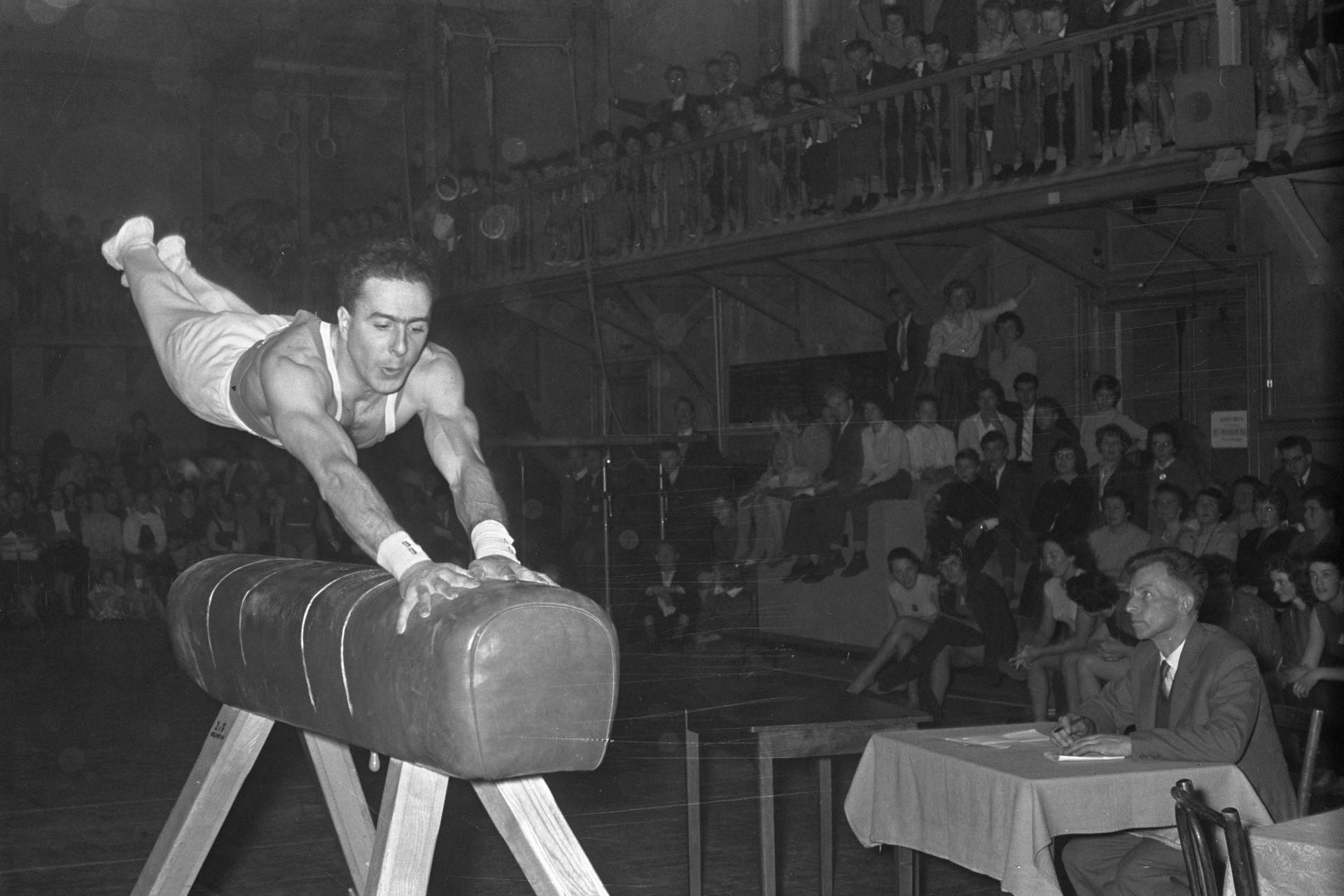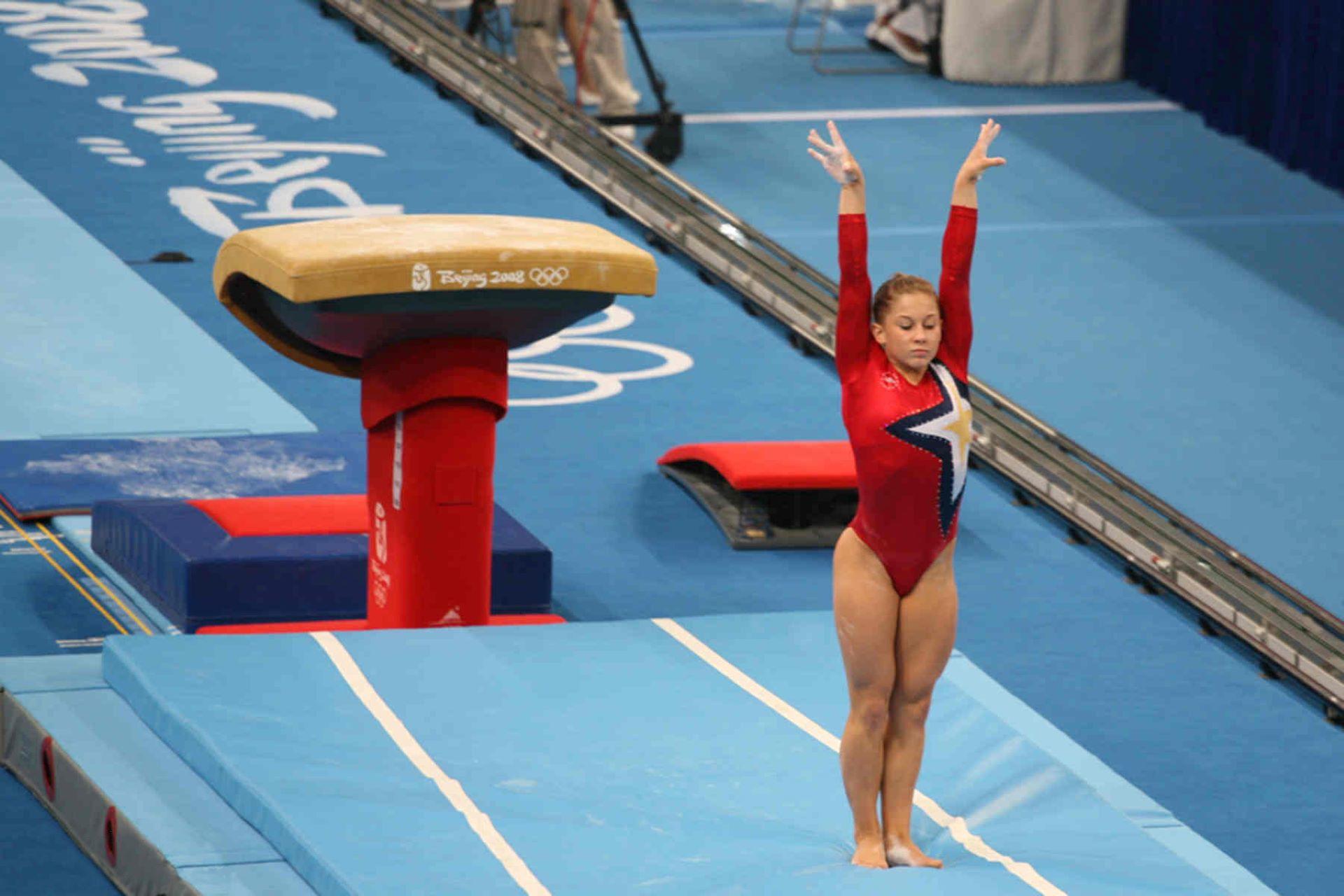In artistic gymnastics, the vault is one of the main events at the Olympic Games.
Today, we'll explore the rich history and thrilling dynamics of the women's vault event, a significant pillar of artistic gymnastics.
So what is it, how did it come to be, and who's the best?
All that and more in this article!

What Is the Vault?
The vault is both the name of the event and the apparatus used by the gymnasts, just like with the uneven bars and balance beam. The vault was similar to a pommel horse without handles, initially called the vaulting horse.

Nowadays, the event actually uses an apparatus known as a vaulting table. This is due to several high-profile incidents with the older apparatus. The vaulting horse was used until 2000 and replaced by the vaulting table.
Gymnasts run up to the vaulting table, propelling themselves onto it using a springboard.
The objective is to spring up from the springboard onto the vaulting table and perform gymnastics in the air before landing in the designated area on the other side of the vaulting table.
The women's vault event, with its explosive nature and brief duration, is a unique spectacle at the Olympic Games. In a matter of seconds, you'll witness some of the most incredible gymnastics.
The History of the Vault
The vault was first held at the first Summer Olympics in 1896. It missed the next Olympics, which only featured one gymnastics event, but it was held again in 1904.
It wasn't until 1928 that women's gymnastics events were included in the Olympic Games, and even then, the 1932 Olympic Games in Los Angeles didn't feature any.
Since 1936, every Summer Olympic Games has included women's gymnastics events, and since the 1952 games, the events program has been fixed for women's events, including the vault, which has been part of 18 different Olympic Games (including the upcoming Paris 2024 Games).
See how the event has changed over time.
How You Are Scored on the Vault
In the women's vault event, gymnasts are scored based on the execution and difficulty of their vaults. The difficulty of each technique is determined by the FIG's Code of Points, which is currently valid for 2022-2024.
There are 9 judges across three panels: The D-panel, the E-panel, and the Reference Panel.
The D-panel consists of two judges. Typically, routines are given a difficulty score with difficulty values from the Code of Points plus connection points.
In the case of the vault, the connection points and the calculation aren't relevant as this is an explosive event over in a few seconds rather than a longer routine.
The vault has a predetermined difficulty score, assigned by the Code of Points, which is shown to the judges at the start of the runway.
The E-panel features six judges and determines the Execution Score. Gymnasts are typically scored starting at 10.0, with deductions removed for errors and other penalties.
The reference panel corrects any issues involved with the Execution Score if necessary.

Top Vault Moves
Just because you know the difficulty score before the runway, that doesn't mean that the vault can't be full of surprises.
All of the top moves are particularly impressive, and we've chosen those with a difficulty score of 5.00 or higher.
They are split into various groups: front handspring with a salto, Tsukaharas, Yurchenkos with full twist in pre-flight, Yurchenkos with half twist in pre-flight, and Yurchenkos.
Front handspring with a salto
- 5.00 - handspring front straight salto with full twist
- 5.10 - handspring front pike salto with 1½ twist
- 5.40 - handspring front straight salto with 1½ twist
- 5.80 - handspring front straight salto with double twist
- 6.00 - handspring double front salto tucked
Tsukaharas
- 5.20 - Tsukahara straight with double twist
Yurchenkos with full twist in pre-flight
- 5.00 - round-off, full twist on, straight back salto with full twist
Yurchenkos with half twist in pre-flight
- 5.00 - round-off, half-on, front tuck salto with 1½ twist
- 5.20 - round-off, half-on, front straight salto with full twist
- 5.20 - round-off, half-on, front pike salto with 1½ twist
- 5.60 - round-off, half-on, front straight salto with 1½ twist
- 6.00 - round-off, half-on, front straight salto with double twist
Yurchenko
- 5.00 - straight Yurchenko with double twist
- 5.40 - straight Yurchenko with 2½ twist
- 6.40 - Yurchenko double pike
Find out more about the Yurchenko in this video.
Top Gymnasts Who Excel on the Vault
Due to the nature of the vault, many excellent gymnasts have taken to the event. Similarly, because of the unique nature of the vault, there have also been many vault specialists who excel on the apparatus rather than being likely contenders for gold medals across the other gymnastics events like the balance beam, uneven bars, or floor exercise.
Simone Biles
One of the most inspiring figures in gymnastics, Simone Biles, has left an indelible mark on the women's vault event. Her exceptional skills and dedication have earned her numerous accolades, including the gold medal for the vault at the 2016 Olympic Games in Rio de Janeiro. Her achievements serve as a testament to the heights that can be reached in the women's vault event.
At the U.S. Classic in 2021, Biles became the first woman to complete a Yurchenko double pike vault, which was given a preliminary D-score of 6.6. This vault is the highest-value vault in women's gymnastics.
at the 2021 U.S. Classic!
McKayla Maroney
McKayla Maroney is another highly decorated American gymnast. She won the silver medal in the vault at the 2012 Olympic Games in London and the gold medal at the World Championships in 2011 in Tokyo and 2013 in Antwerp.
Her silver medal at the London Olympics was a shock following a fall on her second vault after an incredible first vault. A photograph of her on the podium with the silver medal became an internet meme known as "McKayla is not impressed".
Cheng Fei
Cheng Fei is a Chinese gymnast whose powerful and consistent vaulting won several Olympic and World Championship medals.
Between 2005 and 2007, Cheng won three consecutive world titles.
After winning triple World Championship gold medals, she won bronze at the 2008 Olympic Games in Beijing.
Maria Paseka
Russian gymnast Maria Paseka won gold medals in vault at the 2015 World Championships in Glasgow and the 2017 World Championships in Montreal, Canada.
She also won a bronze medal at the 2012 Olympic Games in London and a silver medal at the 2016 Olympic Games in Rio de Janeiro.
Oksana Chusovitina
Oksana Chusovitina is an Uzbekistani gymnast who also represented Germany and the Soviet Union.
While representing Germany, she won the silver medal for the vault in 2008 in Beijing. She also won the silver medal at the World Championships in 2011 in Tokyo and the bronze medal in 2006 in Aarhus.
Representing Uzbekistan at the World Championships, she won the gold medal in 2003 in Anaheim, silver in 2001 and 2005 in Ghent and Melbourne, respectively, and bronze at the 1993 and 2002 World Championships in Birmingham and Debrecen.
Two vault skills are named after Chusovitina, with difficulty scores of 4.4 and 5.4.
Just watch Chusovitina competing at EIGHT Olympic Games!
Chasing the Perfect Vault Score
While those new to gymnastics might like the idea of the perfect 10.0 score, with the vault and two scores, the 10.0 could only ever be for the execution score.
Instead, when it comes to the vault, it's really about finding the balance between executing a difficult vault incredibly well or perfect execution for a vault of a lower difficulty.
Instead of looking for perfect scores when watching the vault, look for scores between 12 and 15. Typically, 15 is an excellent score and will likely win a gold medal. 14s are also likely to win medals. Scores in the 13s will likely rank in the middle of the gymnasts during the event.
Just remember that it depends on the competition, so lower scores can still win. It's about field strength, which can add an exciting dimension to the event. The same is true of the balance beam, uneven bars, and floor exercise.

Learn Gymnastics with Superprof
Whether you want to become a vault specialist, learn gymnastics, or take your gymnastics to the next level, it pays to work with a coach or a private gymnastics tutor.
Many of them are on the Superprof website, so search for what you want to learn and browse their profiles today.
With so many offering the first session for free, you can try a few out before choosing which one is right for you and how you like to train.
Just search for “gymnastics” on the Superprof site today!
















